header image and other screenshots used with permission from Power Pak
There's a lot to cover here, kind of an endless staircase that leads down, always getting darker, always more frightening.
And because there's so much, I can only waste three lines on an intro.
Today, we're talking MyHouse.wad, a Doom mod that slams a fresh, new, Hell On Earth style of storytelling down on the table.
Doom
You only need to know a tiny bit about Doom in order to understand everything else in this column, and you can skip this section (and the next) if you’re familiar with Doom and modding.
In fact, you Doomguys had probably better skip it. If you’re hardcore into this stuff, my explanations will probably put you in a berserker-style correction mode that'll help no one.
For the noobs:
Doom is a first-person shooter (if you play the game as a character, and you’re looking through their eyes as you pull the trigger, it’s a first-person shooter). More than that, Doom is THE first-person shooter.
Doom was released in 1993, and while it wasn’t the first game of its kind, it so defined the first-person shooter that, for a long time, other FPS games were called “Doom clones.”
In Doom, you play as a space marine often called “Doomguy” who walks through facilities and hallways infested with monsters from hell.
There’s something about hell encroaching on a Phobos base or something, and really, that’s not important. As Doom co-creator John Carmack says, video game stories are a little like stories in porn: people expect them to be there, but that’s not why they show up.
Doom: Walk around, blast monsters, find keys, open doors, exit levels, repeat.
Doom Modding
One thing that made Doom fairly unique, and something that contributed to its longevity, was that it was released with modding in mind.
Johns Romero and Carmack, two of the leads behind Doom, made sure that the level-building tools and the engine that made the game run were separate, meaning people could create levels without needing to recode or remake the entire Doom engine.
This is a bit technical, but think of it like a car: you could change out the appearance of the car, the layout of the interior, and customize a lot of it without ever touching the engine or drivetrain. The car would still run with just about any aesthetic changes made.
Doom worked the same way: people could design their own levels, their own arenas, and these would be playable almost immediately.
Lots of these mods were posted online or sold on 3.5” floppy. These are often knows as “wads.” Others were even officially packaged and sold by id Software, makers of Doom.
Doom mods ran the gamut. Many were Doom levels, indistinguishable from a normal Doom level (although satisfaction will vary).
Then there were folks who did a little more tinkering with Doom to do things like change the character sprites, sound effects, and some of the visuals to create something that behaved like Doom, but instead of looking like Doom, took on the world of Batman, or, famously, creating a Doom-like game where a...Chex man blasted weird aliens in order to promote Chex cereal somehow?
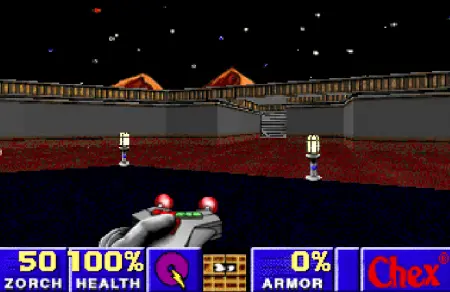
We’ll get back to more mods shortly, but in order to preserve some surprise, let’s get into My House.
MyHouse.wad
A post-er on the Doom forums released My House in March of 2023 with the following message:
Excited to finally release this tribute map. Last August I lost a good childhood friend of mine and took it pretty hard. When I was visiting my hometown for his funeral, I connected with his parents who shared with me some of his old belongings. Among them was a copy of an old map of his backed up on a 3.5” floppy from high school. Thomas and I were into amateur Doom mapping in the early 00s but I had never seen this map of his prior to uncovering it on one of the old floppy discs. As a way of paying tribute to him and all the great memories we had together, I took the plunge and installed Doom Builder in order to polish up his map and add a few modern amenities just for convenience sake...1 map: Not much of a challenge and roughly 10 minutes of play time...Making maps of your house was all the rage back-in-the-day, but I feel like this is a pretty adorable and detailed tribute to my friend and a great way to share something of him with a community we loved. Miss you, Tom.
Spoiler Stop
Now, at this point, if you are someone familiar with Doom who enjoys unusual narratives, and if you have NOT heard, read, or seen anything about this wad, I encourage you to go and play it for yourself. It’s available for free.
The optimal player experience here is to read the above text, load up My House, and go for it without any further Googling.
Play it at night. Alone.
For those who aren’t going to play, let’s rip and tear into this one.
Playing My House
My House starts like exactly what it claims to be: a fairly typical suburban house, created in Doom.
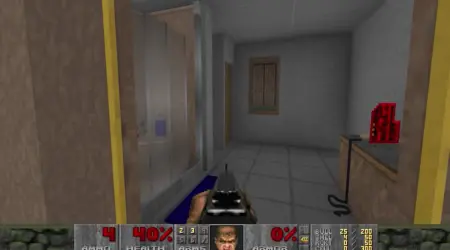
The play style is typical Doom. You enter the house, fight some of the familiar roster of monsters using the familiar weapons of Doom, grab a couple keys, you get the idea.
If you were to play through this and quit because while My House is interesting, it didn't seem all that deep, that'd be understandable.
But if you did this, you'd miss everything.
Because the more you do in the house, the weirder this starts to get.
Where Being A DoomGuy Comes In Handy
I watched John Romero, co-creator of Doom, play My House, which is a cool experience.
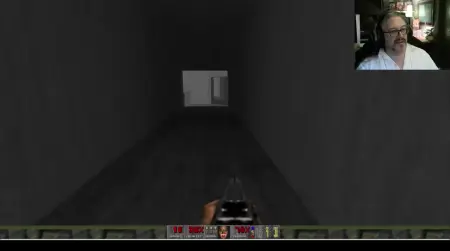
image
Because Romero knows Doom inside and out, he quickly picks up on some of the very minute changes to Doom’s structure and aesthetics, which show up pretty early in My House.
An inexperienced player wouldn’t notice that, at some point, doors in My House swing open instead of shooting up into an overhead pocket, the way they do in Doom.
John Romero almost instantly noticed that the normal Doom music changes. Not drastically, but subtly. It gets a little more manic.
Maybe a big one: the engine for Doom does not allow one floor to be above another. So, if you made a house in Doom, you’d have to cheat it, put the lower floor off to the side.
In My House, the layout is a house with multiple floors on top of each other, which should be impossible.
Because you aren't John Romero, you might even miss that the house grows new enemies not present on the first runthrough, and you might not notice that the keycards have changed to the skullkey type of key.
There are a lot of little things you might miss, and this is the hump to get over in My House: If you’re not a big Doom-er and don’t know this stuff, give the wad a little extra time to get weird. It’s worth the wait.
If you loaded Doom onto an old PC using 4 floppy disks, you'll appreciate My House's slow, ominous descent into madness almost right away.
And the beauty of it all is that everything is intentional. Each detail is carefully crafted to lure you into an experience within Doom you'd never have thought possible.
And Then…
I don’t want to describe everything in My House, it can’t be done justice in print.
But let me give you some ideas.
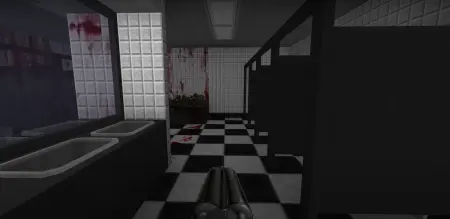
You’ll enter alternate versions of the same house. Maybe it’s been burned down, or its overgrown with plant life, or it has a new, modern aesthetic.
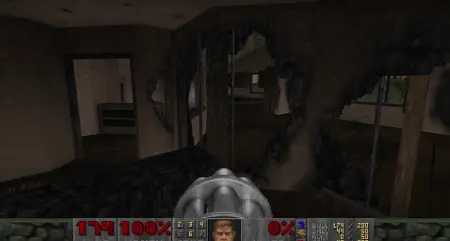
You’ll enter impossible spaces, rooms that seem to exist in the same physical space at the same time, overlapping each other.
You’ll find yourself in an underwater labyrinth, struggling to escape before your air runs out.
You’ll find yourself in an airport and aboard a plane.
You’ll find yourself in fabled creepypasta backrooms and liminal spaces.
You'll enter doors that lead to uncanny areas, a world of open sky or a huge, pulsating box.
You'll slide into a ball pit.
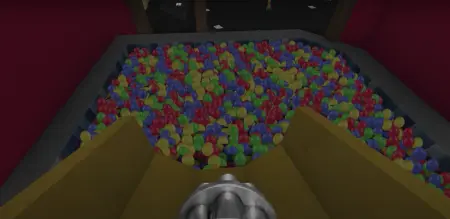
Each door you open, each path you take, makes everything stranger.
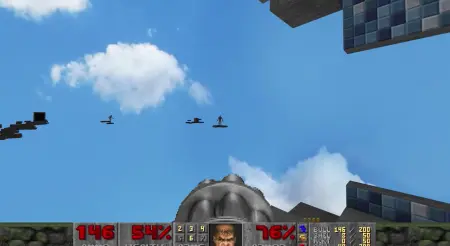
What appears on the surface to be an unfinished Doom map, compiled by a friend of the deceased original creator, is a surreal experience, a monumental technical achievement that plays with what we know Doom wads, and videogames in general, to be.
And it's a masterclass in storytelling. The tension ratchets up just a tiny bit at a time. It tricks you into thinking you're innocently playing a Doom mod, when what you're really doing is assembling a story.
Unusual Mods
There are other mods/wads that are pretty unusual, and My House can trace its DNA back to some of these.
I’m not talking about the wads that change all the characters into Simpsons characters (although this is pretty great) or something like that.
I'm talking about:
The Sky May Be: A wad that’s just…odd. Strange textures, ill-fitting sound effects, the whole thing feels like an accident, except it can’t be, because someone had to program this to happen.
ARCHIE: ARCHIE is a high-surrealism modern doom wad with an equally high system requirement. It tells a story about hipsters using technology to create a singularity timesink from which they can never escape, on purpose, and how they affect those around them with something that isn't real.
The Harris Levels: Not so much notorious for their contents, but for their creator: Eric Harris, one of the two shooters at Columbine High School (this played no small part in Doom’s reputation for harming the children).
These wads do something different. They force the player and the game to interact on a new level. These types of wads force the player to consider the wad’s maker, as does My House with its backstory (above) as well as some additional information included in the download.
House of My House
We’re not going to cover the entirety of House of Leaves here because that book has been out forever, it’s wonderful, you’re probably aware of it.
The big takeaway for House of Leaves is this: I’m a reader who has a limited tolerance for bullshitty novelty in books. I’m totally good with weird formats and oddity provided there’s also a story in the text.
Maybe another way to look at this: if a book’s unusual structure is an enhancement, a perfect side dish, while still having a good story as the star of the meal, I’m in.
House of Leaves is well worth the effort.
My House and House of Leaves share some surface level similarities that are clear to fans of both.
In front of the titular house in My House, a real estate sign for Navidson Real Estate, a reference to Will Navidson from House of Leaves.
Like in the book House of Leaves, text files that accompany My House have the word “house” highlighted in blue.
An endless staircase is a clear nod as well.
But these are just references. The way both My House and House of Leaves work is where things get interesting.
House of Leaves
I once saw House of Leaves author Mark Z. Danielewski give a talk while on tour for Only Revolutions, and he described the reading experience in his books as being like climbing a mountain. There’s usually more than one way to get to the top, some are probably easier than others, some more linear, some with switchbacks, and all the different routes are better or worse depending on what you bring to the table as a climber.
And that’s how My House works as well. It’s a story, it’s finite, and you can complete or conquer it. But your experience and mine will be totally different because of what we bring to it and because of the choices we make along the way.
Both are participatory in that way. Both put a sense of guilt into the person experiencing them.
You, as reader or as player, are complicit in assembling these events.
Uncanny
House of Leaves takes a collection of objects, letters, diary entries, various documents, compiles them into the familiar form of a book, and then, by using them in such an unusual way, builds a sense of the uncanny: something that feels familiar also feels, well, wrong.
The House in House of Leaves works this way as well. One of the earlier discoveries about the house is that it is, somehow, slightly larger INSIDE than it is OUTSIDE.
By making home, a solid thing made of real materials, into something impossible, the book plays on the fear of things that are inexplicable, that we are living in a world that is still not really understood.
In My House, everything familiar about Doom becomes unfamiliar in a way that’s eerie, a way that’s uncomfortable. It can’t be overstated how bizarre it feels to engage in a surreal narrative while also seeing the familiar Doomguy heads-up display, Doomguy’s wandering eyes, and a pistol or shotgun out in front of you with that familiar Doom walk cycle.

At some point in My House, thinking about things like armor or how many rockets you have reminds you of just how deep into a rabbit hole you've tumbled.
Both My House and House of Leaves show us the horror in using the language of something we think we understand, and then twisting it in a way that leaves us on unsteady ground.
The places we thought were safe retreats, books and video games, are not.
Ergodic Houses
The fancy term people use for House of Leaves is “ergodic literature.” This is a term for books that:
- Require a special effort on the part of readers to assemble a narrative
- Have, built in, some way that demonstrates the difference between a successful and unsuccessful reader
House of Leaves is a book that certainly requires special effort on the part of the reader as one cannot just go from top to bottom, left to right.
House of Leaves doesn't have a great way of gauging the success of the reader.
And this is why I think My House may be an even more successful version of ergodic storytelling than House of Leaves, which I'd previously considered the absolute peak.
Because My House is a game, and because the player must take certain actions, in a certain order, to put the narrative together, it easily fulfills the first condition of ergodic lit.
But even in the context of gaming, where a player has to make effort to complete the narrative, My House is a more obtuse, non-linear experience than you'll find in most games. It’s not even clear that a narrative exists at the outset, and it requires the player to do things that are very unusual in the Doom environment (one YouTube commenter observed that seasoned Doom players seem to have trouble with My House because their seasoning in the fires of Doom's hells teach them to expect the game to work a certain way).
And because the game’s different endings can provide a sense of either peace or (heh) doom, players are able to interpret these endings and see whether or not they were successful in assembling the narrative. The “final page” of the story doesn't only hit differently, it actually IS different depending on what the player manages to do.
Both My House and House of Leaves are stories within unusual structures within hyper-normal structures. Both function as puzzles, and the reward for solving the puzzles is narrative.
But I have to say, My House is better at telling me whether or not I made it to the top of the mountain.
My House of Leaves
I’m overjoyed that My House exists. Because it brings House of Leaves back into the conversation, and because it is, itself, a wonderful storytelling achievement.
It’s dark, it’s harrowing, it’s a game AND a story.
The narrative, both within and outside of the actual gameplay, is fascinating.
It probably sounds weird to say that a Doom wad is the next evolution of storytelling. I mean, how can a game from the early 90s be on the cutting edge?
But House of Leaves changed storytelling by messing with books, and those were by no means new technology in 2000.
And My House’s presentation within such a ubiquitous, iconic game gives it something extra, brings out fear and curiosity.
I don't often feel a lot of fear or tension when I watch movies or play games.
I felt a sense of dread in My House. A creeping, confining fear I haven't felt since I sat, reading House of Leaves, sweating while I turned the pages.
Experience My House
If you are not a Doom-er and want to see My House for yourself, I highly recommend this video by Power Pak on YouTube, which will walk you through the wad (the screenshots I’ve used here were from his video, with permission, and he seems like a very nice person). It's about 2 hours long, so pop some popcorn, watch it like a movie. You'll love it. You don't have to know anything about Doom to get a lot out of it.
If you’d like to see My House played by an experienced gamer, this video uploaded by John Romero is pretty interesting as well. He has a lot of insight into where the game does and does not violate the normal function of Doom in service of storytelling, plus an appreciation for interesting use of textures and details down to door swing sound effects.
If you're a gamer ready and willing to play My House yourself, here you go!
Get House of Leaves: The Remastered Full-Color Edition at Amazon
Get Masters of Doom: How Two Guys Created an Empire and Transformed Pop Culture by David Kushner at Bookshop or Amazon
Get Doom Guy: Life in First Person by John Romero at Bookshop or Amazon

About the author
Peter Derk lives, writes, and works in Colorado. Buy him a drink and he'll talk books all day. Buy him two and he'll be happy to tell you about the horrors of being responsible for a public restroom.







